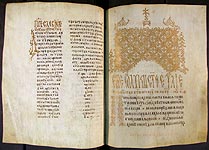Tetraevangelion.
16th cent. Wallachian Moldavian version (Moldavian type)
F (330 ı 260). I + 237 leaves. (236 + 1 marked with a letter).
Parchment. Ink, cinnabar, gold.
It is written in a semi-uncial hand. Spellings are typical of manuscripts of Moldavian origin.
The manuscript contains the interlaced head-pieces, worked in cinnabar (fols. 1r, 108v) and gold (fols. 4r, 67r, 69r, 110r, 175v, 177r, 226r). Folio 229v bears dividing ornamental bars, drawn in cinnabar and ink. Large initials on fols. 4r, 69r, 110r, 177r and thin ornamental initials throughout the all codex, punctuation dots throughout the book, partially - running titles, colophonones and etc.- are written in gold.
Applied covers, made of engraved metal, are set onto the boards of the binding. The upper applied cover is adorn with stones (malachite etc.).
The manuscripts contains two inscriptions with a false date of its creation (1264).
The book is richly embellished with the abundance of gold, but portraits of the Evangelists, typical for the Four Gospels, are now lacking. The manuscript may have originally contained the portraits. They were cut out later. Narrow strips of inner margins, which were left after leaves had been cut out of the book, are seen at the begginings of the Gospels of Matthew, Mark and Luke. The leaf, preceding the Gospel of John, survives only in a fragment, closely approximate to the spine.
In 1852 the manuscript came into the Imperial Public Library along with the other contents of the collection of Mikhail Pogodin, the noted historian, writer and collector.
Shelfmark: –Õ¡. œÓ„Ó‰. 23.





